īů—ß…ķ§ň§Ť§Í Ļ§§§š§Ļ§§Īűį’Ľ∑ĺ≥
Download as pptx, pdf0 likes739 views
WebRTC Conference Japan÷v—›ŔYŃŌ 2015/2/5 °łīů—ß…ķ§ň§Ť§Í Ļ§§§š§Ļ§§Īűį’Ľ∑ĺ≥°Ļ
1 of 12
Downloaded 11 times
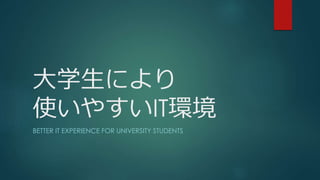
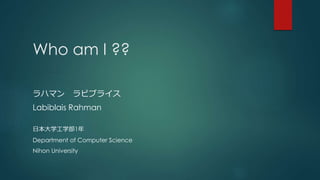

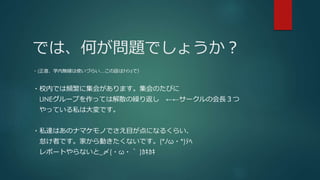


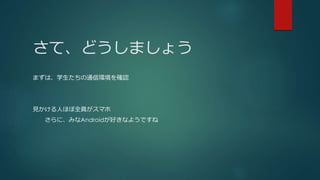
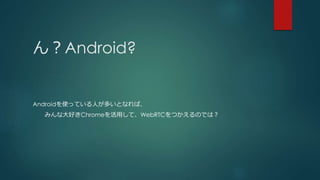
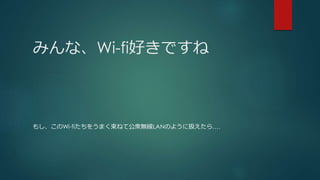
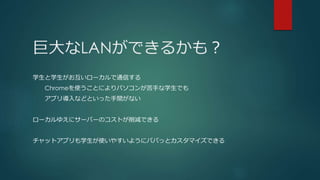
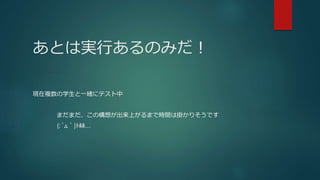

Ad
Recommended
Kosen_conf_in_Sendai2_20130806
Kosen_conf_in_Sendai2_20130806Yudai Hashimoto
?
I talked about Micro-controller in KosenConf. in Sendai2.
This is about that.—ß…ķ§»Īű≥Ŕ•≥•Ŗ•Ś•ň•∆•£§őŌ÷‘ŕ£®§§§ř£©
—ß…ķ§»Īű≥Ŕ•≥•Ŗ•Ś•ň•∆•£§őŌ÷‘ŕ£®§§§ř£©Shoot Morii
?
Open Source Comference 2010 Kansai @ Kobe
•’•©•ů•»§¨≤–ńÓ§ §ő§Ō‘S§∑§∆§Į§ņ§Ķ§§°£http://www.ustream.tv/recorded/5405750itss_nagoya_chapter_2019_second_akai
itss_nagoya_chapter_2019_second_akaiNaoki Akai
?
IEEE ITS Society √ŻĻŇő›•Ń•„•◊•Ņ©`
IEEE/RSJ IROS2019≤őľ”ąůłś£®≥ŗĺģ§¨IROS2019§«įkĪŪ§∑§Ņńŕ»›§Úļ¨§ŗ£©§ń§Į§–•Ń•„•ž•ů•ł2020Ķŕ1ĽōLTīůĽŠ ≠hĺ≥ČšĽĮ§ňÓBĹ°§ LiDAR•Ŕ©`•Ļ§ő◊‘ľļőĽ÷√Õ∆∂®
§ń§Į§–•Ń•„•ž•ů•ł2020Ķŕ1ĽōLTīůĽŠ ≠hĺ≥ČšĽĮ§ňÓBĹ°§ LiDAR•Ŕ©`•Ļ§ő◊‘ľļőĽ÷√Õ∆∂®Naoki Akai
?
§ń§Į§–•Ń•„•ž•ů•ł2020Ķŕ1Ľō≥Ęį’īůĽŠ§« Ļ”√§∑§Ņ•Ļ•ť•§•…02172016 web rtc_conf_komasshu
02172016 web rtc_conf_komasshuKensaku Komatsu
?
WebRTC Conference Japan 2016 §«§őLTŔYŃŌ°£ĪĪ√◊§ő◊Ó–¬ ¬«ť§»§»§‚§ň°Ę•≥•ů•∑•Ś©`•ř©`IoT §ő¨F‘ŕ£¶őīņī”Ťúy§»WebRTC§¨§‚§Ņ§ť§Ļ§‚§ő§√§∆ł–§łWebController for V-Sido Connect£ļWebRTC§»WebGL§«◊ų§Ž»ň–Õ•Ū•‹•√•»ŖhłŰ≤ŔŅk•∑•Ļ•∆•ŗ(2)
WebController for V-Sido Connect£ļWebRTC§»WebGL§«◊ų§Ž»ň–Õ•Ū•‹•√•»ŖhłŰ≤ŔŅk•∑•Ļ•∆•ŗ(2)WebRTCConferenceJapan
?
WebRTC Conference Japan 2016 įkĪŪŔYŃŌ
÷Í ĹĽŠ…Á•Ę•»•‚•Ļ•«•∂•§•ů°°ÉĻ”٧Ķ§ůWebController for V-Sido Connect£ļWebRTC§»WebGL§«◊ų§Ž»ň–Õ•Ū•‹•√•»ŖhłŰ≤ŔŅk•∑•Ļ•∆•ŗ(1)
WebController for V-Sido Connect£ļWebRTC§»WebGL§«◊ų§Ž»ň–Õ•Ū•‹•√•»ŖhłŰ≤ŔŅk•∑•Ļ•∆•ŗ(1)WebRTCConferenceJapan
?
WebRTC Conference Japan 2016 įkĪŪŔYŃŌ
2016/2/17 •Ę•Ļ•ť•∆•√•Į÷Í ĹĽŠ…Á ĹŮĺģ§Ķ§ů•Ū•‹•√•»∑®®D•Ū•‹•√•»?»ňĻ§÷™ń‹§ňťv§Ļ§Ž∑®Ķń÷ÓŅőŐ‚§»’ĻÕŻ
•Ū•‹•√•»∑®®D•Ū•‹•√•»?»ňĻ§÷™ń‹§ňťv§Ļ§Ž∑®Ķń÷ÓŅőŐ‚§»’ĻÕŻFumiko Kudoh
?
Ķŕ∂ĢĖ|ĺ©ŘÕ◊o ŅĽŠ «ťąůĻęť_?āÄ»ň«ťąůĪ£◊oőĮÜTĽŠ÷ųīŖ§«•Ŗ•ň÷vŃx§Ú§∑§ŅŽH§őŔYŃŌ§«§Ļ£®2016ńÍ2‘¬3»’£©į¬Īū≤ķłťį’įš§¨…Ó§Š§Ž§™ŅÕėĒ§»Ļęňĺ§ő•≥•Ŗ•Ś•ň•Ī©`•∑•Á•ů
į¬Īū≤ķłťį’įš§¨…Ó§Š§Ž§™ŅÕėĒ§»Ļęňĺ§ő•≥•Ŗ•Ś•ň•Ī©`•∑•Á•ůWebRTCConferenceJapan
?
WebRTC Conference Japan 2016 įkĪŪŔYŃŌ
2016/2/17 CafeX Communications Rami Musallam§Ķ§ůUser Experience is Everything
User Experience is EverythingWebRTCConferenceJapan
?
The document discusses the development and user experience focus of appear.in, a video conferencing service designed for ease of use without installation or login requirements. It emphasizes the importance of incorporating user feedback and maintaining a familiar interface to retain users, while acknowledging that overly complicated innovations can deter usage. The potential of WebRTC technology is highlighted as a foundational element of the service, enabling innovative user experiences.į¬Īū≤ķłťį’įš§¨«–§ÍÕō§Į2020ńͧőĪűī«į’
į¬Īū≤ķłťį’įš§¨«–§ÍÕō§Į2020ńͧőĪűī«į’WebRTCConferenceJapan
?
WebRTC Conference Japan 2016 įkĪŪŔYŃŌ
2016/2/16 Ōń“įĄā§Ķ§ů°Ęľįī®◊Ņ“≤§Ķ§ů°Ęį◊ ĮŅ°∆ŧĶ§ů ŐōĄeĆĚ’ĄValue Added Services and WebRTC
Value Added Services and WebRTCDialogic Inc.
?
The document discusses value-added services using WebRTC technology. It begins by outlining challenges currently facing enterprises and service providers, such as improving mobile experiences and reducing costs. It then examines how WebRTC could address these challenges by enabling new communication applications. Examples of potential WebRTC uses are presented across vertical industries like healthcare, IoT, and special needs, as well as for customer management, collaboration, and broadcasting. The document concludes by speculating on future directions such as using the data channel, moving beyond phone numbers with digital identity, and incorporating artificial intelligence into services.WebRTC NextVersionērīķ§őJavaScriptť_įk
WebRTC NextVersionērīķ§őJavaScriptť_įkYusuke Naka
?
WebRTC Conference Japan 2016§őįkĪŪŔYŃŌ§«§Ļ°£
§Ô§ę§Í§ň§Į§§Ķ„§¨“Ľ§ń§Ę§Í§ř§∑§Ņ§ő§«—a◊„§«§Ļ°£
WebRTC NV§»§∑§∆•Ū©`•ž•Ŕ•ŽAPI§ő‘í§ÚORTC§ÚÓ}≤ń§ň§∑§∆§™§Í§ř§Ļ§¨°ĘORTC§őAPI§Ō“Ľ≤ŅWebRTC 1.0§ň ʧÍřz§ř§ž§ř§Ļ°£
ņż§®§–°ĘRtpSender / Receiver, Ice/Dtls/SctpTransport Ķ»°£
§…§≥§ř§« ʧÍřz§ř§ž§Ž§ő§ę§Ō°ĘĹŮŠŠ‘ϧŠ§ť§ž§∆§§§Į§‚§ő§ņ§»ňľ§√§∆§§§ř§Ļ°£
≤őŅľ£ļP16
į¬Īū≤ķłťį’įš§«ĆgŌ÷§Ļ§Ž•™•ů•ť•§•ů”ĘĽŠĽį§őőīņī
į¬Īū≤ķłťį’įš§«ĆgŌ÷§Ļ§Ž•™•ů•ť•§•ů”ĘĽŠĽį§őőīņīWebRTCConferenceJapan
?
WebRTC Conference Japan 2016 įkĪŪŔYŃŌ
2016/2/17 •ž•Ę•ł•Á•÷ żSŐŔŅ°» §Ķ§ů°Ęň……ĹĹķ§Ķ§ůWebRTC•ť•§•»•ň•ů•į•»©`•Į•Ļ ? WebRTC§Ú…ę°© Ļ§√§∆§Ŗ§Ņ‘í
WebRTC•ť•§•»•ň•ů•į•»©`•Į•Ļ ? WebRTC§Ú…ę°© Ļ§√§∆§Ŗ§Ņ‘íinfocom corp.
?
WebRTC Conference Japan 2016 •Ļ•›•ů•Ķ©`•Ľ•√•∑•Á•ůįkĪŪŔYŃŌį¬Īū≤ķłťį’įš§«∂Į§ę§Ļ°į•∆•ž•§•Į?•∑?•Ļ•Ņ•ů•Ļ°Ī•Ū•Ř?•√•»
į¬Īū≤ķłťį’įš§«∂Į§ę§Ļ°į•∆•ž•§•Į?•∑?•Ļ•Ņ•ů•Ļ°Ī•Ū•Ř?•√•»NTT Communications Technology Development
?
WebRTC Conference Japan 2016 (2016ńÍ2‘¬16»’) §ő÷v—›ŔYŃŌ§«§Ļ°£
įkĪŪ’Ŗ§Ō÷– i¬á‘’§»īůĹÚĻ»ŃŃĶv http://www.slideshare.net/rotsuya §«§Ļ°£
°įTelexistence Robot controlled with WebRTC°Ī
It's the presentation slides at WebRTC Conference Japan on Feb 16, 2016.
The presenters were Toshiya Nakakura and Ryosuke Otsuya http://www.slideshare.net/rotsuya .į¬Īū≤ķłťį’įš•Ķ©`•”•Ļ§ÚłŲ»ň§«‘ňÜ”§∑§∆§Ŗ§ŅĽį
į¬Īū≤ķłťį’įš•Ķ©`•”•Ļ§ÚłŲ»ň§«‘ňÜ”§∑§∆§Ŗ§ŅĽįJunki Mizushima
?
WebRTC conference Japan 2016§őįkĪŪŔYŃŌ§«§ĻWeb of Things§ő¨F◊ī§»WebRTCĽÓ”√§őŅ…ń‹–‘
Web of Things§ő¨F◊ī§»WebRTCĽÓ”√§őŅ…ń‹–‘Kensaku Komatsu
?
WebRTC Conference 2015 ( http://webrtcconference.jp/ )§«§őįkĪŪŔYŃŌ°£
Web of Things§»Internet of Things§őťvāS§š°ĘWebRTC§ §…Web•◊•Ū•»•≥•Ž§őŖMĽĮ§ňįť§¶°ĘWoT§őŅ…ń‹–‘§őíąīů§ň§ń§§§∆ ¬ņż§Úļ¨§ŠĹBĹť§∑§∆§§§ř§Ļ°£WebRTC on Native App
WebRTC on Native AppWebRTCConferenceJapan
?
WebRTC Conference Japan 2016 įkĪŪŔYŃŌ
2016/2/17 •ň•Ś©`•’•©•Í•Ę ģÉŐÔŌ≤’…§Ķ§ůThe missing signalling layer for WebRTC
The missing signalling layer for WebRTCWebRTCConferenceJapan
?
The document discusses the lack of a standardized signaling protocol in WebRTC, emphasizing the need for open, decentralized communication solutions like Matrix. Matrix is presented as a non-profit, open-source project that supports various messaging and VoIP applications, offering a federated architecture and JSON-based API. It aims to enable users to communicate across different applications while maintaining control over their data and privacy.Global Step Academy §őWebRTCĽÓ”√ ¬ņż
Global Step Academy §őWebRTCĽÓ”√ ¬ņżWebRTCConferenceJapan
?
WebRTC Conference Japan 2016 įkĪŪŔYŃŌ
2016/2/17 Global Step Academy •‚•ů•»•ī•Š•Í©`Ķņĺw§Ķ§ů°ĘĀwŐÔŌť∆ŧĶ§ůį¬Īū≤ķłťį’įš§»∂ŔĺĪ≤ĻĪŰī«≤ĶĺĪ≥¶§»§őťv§Ô§Í
į¬Īū≤ķłťį’įš§»∂ŔĺĪ≤ĻĪŰī«≤ĶĺĪ≥¶§»§őťv§Ô§ÍWebRTCConferenceJapan
?
WebRTC Conference Japan 2016 įkĪŪŔYŃŌ
2016/2/16 Dialogic Japan ĄŔ“ä’ż§Ķ§ůHTML5 API§»ĹM§ŖļŌ§Ô§Ľ§∆◊ų§ŽWebRTC•Ę•◊•Í
HTML5 API§»ĹM§ŖļŌ§Ô§Ľ§∆◊ų§ŽWebRTC•Ę•◊•ÍWebRTCConferenceJapan
?
WebRTC Conference Japan÷v—›ŔYŃŌ
2015/2/6 °łHTML5 API§»ĹM§ŖļŌ§Ô§Ľ§∆◊ų§ŽWebRTC•Ę•◊•Í°Ļį¬Īū≤ķłťį’įš£ę•™•Ľ•Ū
į¬Īū≤ķłťį’įš£ę•™•Ľ•ŪWebRTCConferenceJapan
?
WebRTC Conference Japan÷v—›ŔYŃŌ
2015/2/5 °łWebRTC+•™•Ľ•Ū°Ļį¬Īū≤ķłťį’įšťvѨľľ ű§őĪÍú ĽĮ∂ĮŌÚ
į¬Īū≤ķłťį’įšťvѨľľ ű§őĪÍú ĽĮ∂ĮŌÚWebRTCConferenceJapan
?
Dokumen tersebut membahas tentang proses komunikasi antara klien dan server untuk mengonfirmasi konektivitas melalui pertukaran kandidat alamat IP dan port (ICE candidate) serta permintaan konfirmasi konektivitas (connectivity check). Proses tersebut melibatkan beberapa tahapan seperti pengiriman sinyal, permintaan kandidat alamat, konfirmasi konektivitas, hingga kesepakatan konektivitas antara klien dan server.GENBAND ®C KANDY Web-enabled Communications
GENBAND ®C KANDY Web-enabled CommunicationsWebRTCConferenceJapan
?
GENBAND is a Texas-based communications technology company with about 1,600 global employees across 5 development sites and local offices in 80 countries. It provides real-time communication solutions using voice and media gateway technologies to help customers improve productivity and reduce costs. Kandy is GENBAND's real-time mobile and web communication platform hosted in the cloud, delivering voice, video, messaging and collaboration through simple SDKs and APIs. It allows developers to offer real-time communications in applications on any device by wrapping GENBAND's communication assets into a developer-friendly cloud service.The WebRTC Continuum - The Next Wave
The WebRTC Continuum - The Next WaveWebRTCConferenceJapan
?
The document discusses trends in WebRTC adoption and deployment. It notes that WebRTC deployments are expected to triple in 2015. It also discusses challenges around mobility, reliability, and interoperability that need to be addressed for wider WebRTC adoption beyond early adopters. Specifically, it outlines needed improvements in native mobile applications, connectivity capabilities, and network functionality to help WebRTC cross the chasm into mainstream use.•®•ů•Ņ©`•◊•ť•§•ļĽ∑ĺ≥§ň§™§Ī§Žį¬Īū≤ķłťį’įšĽÓ”√§ő•›•§•ů•»
•®•ů•Ņ©`•◊•ť•§•ļĽ∑ĺ≥§ň§™§Ī§Žį¬Īū≤ķłťį’įšĽÓ”√§ő•›•§•ů•»WebRTCConferenceJapan
?
WebRTC Conference Japan÷v—›ŔYŃŌ
2015/2/5 °ł•®•ů•Ņ©`•◊•ť•§•ļĽ∑ĺ≥§ň§™§Ī§Žį¬Īū≤ķłťį’įšĽÓ”√§ő•›•§•ů•»°ĻMore Related Content
Viewers also liked (11)
•Ū•‹•√•»∑®®D•Ū•‹•√•»?»ňĻ§÷™ń‹§ňťv§Ļ§Ž∑®Ķń÷ÓŅőŐ‚§»’ĻÕŻ
•Ū•‹•√•»∑®®D•Ū•‹•√•»?»ňĻ§÷™ń‹§ňťv§Ļ§Ž∑®Ķń÷ÓŅőŐ‚§»’ĻÕŻFumiko Kudoh
?
Ķŕ∂ĢĖ|ĺ©ŘÕ◊o ŅĽŠ «ťąůĻęť_?āÄ»ň«ťąůĪ£◊oőĮÜTĽŠ÷ųīŖ§«•Ŗ•ň÷vŃx§Ú§∑§ŅŽH§őŔYŃŌ§«§Ļ£®2016ńÍ2‘¬3»’£©į¬Īū≤ķłťį’įš§¨…Ó§Š§Ž§™ŅÕėĒ§»Ļęňĺ§ő•≥•Ŗ•Ś•ň•Ī©`•∑•Á•ů
į¬Īū≤ķłťį’įš§¨…Ó§Š§Ž§™ŅÕėĒ§»Ļęňĺ§ő•≥•Ŗ•Ś•ň•Ī©`•∑•Á•ůWebRTCConferenceJapan
?
WebRTC Conference Japan 2016 įkĪŪŔYŃŌ
2016/2/17 CafeX Communications Rami Musallam§Ķ§ůUser Experience is Everything
User Experience is EverythingWebRTCConferenceJapan
?
The document discusses the development and user experience focus of appear.in, a video conferencing service designed for ease of use without installation or login requirements. It emphasizes the importance of incorporating user feedback and maintaining a familiar interface to retain users, while acknowledging that overly complicated innovations can deter usage. The potential of WebRTC technology is highlighted as a foundational element of the service, enabling innovative user experiences.į¬Īū≤ķłťį’įš§¨«–§ÍÕō§Į2020ńͧőĪűī«į’
į¬Īū≤ķłťį’įš§¨«–§ÍÕō§Į2020ńͧőĪűī«į’WebRTCConferenceJapan
?
WebRTC Conference Japan 2016 įkĪŪŔYŃŌ
2016/2/16 Ōń“įĄā§Ķ§ů°Ęľįī®◊Ņ“≤§Ķ§ů°Ęį◊ ĮŅ°∆ŧĶ§ů ŐōĄeĆĚ’ĄValue Added Services and WebRTC
Value Added Services and WebRTCDialogic Inc.
?
The document discusses value-added services using WebRTC technology. It begins by outlining challenges currently facing enterprises and service providers, such as improving mobile experiences and reducing costs. It then examines how WebRTC could address these challenges by enabling new communication applications. Examples of potential WebRTC uses are presented across vertical industries like healthcare, IoT, and special needs, as well as for customer management, collaboration, and broadcasting. The document concludes by speculating on future directions such as using the data channel, moving beyond phone numbers with digital identity, and incorporating artificial intelligence into services.WebRTC NextVersionērīķ§őJavaScriptť_įk
WebRTC NextVersionērīķ§őJavaScriptť_įkYusuke Naka
?
WebRTC Conference Japan 2016§őįkĪŪŔYŃŌ§«§Ļ°£
§Ô§ę§Í§ň§Į§§Ķ„§¨“Ľ§ń§Ę§Í§ř§∑§Ņ§ő§«—a◊„§«§Ļ°£
WebRTC NV§»§∑§∆•Ū©`•ž•Ŕ•ŽAPI§ő‘í§ÚORTC§ÚÓ}≤ń§ň§∑§∆§™§Í§ř§Ļ§¨°ĘORTC§őAPI§Ō“Ľ≤ŅWebRTC 1.0§ň ʧÍřz§ř§ž§ř§Ļ°£
ņż§®§–°ĘRtpSender / Receiver, Ice/Dtls/SctpTransport Ķ»°£
§…§≥§ř§« ʧÍřz§ř§ž§Ž§ő§ę§Ō°ĘĹŮŠŠ‘ϧŠ§ť§ž§∆§§§Į§‚§ő§ņ§»ňľ§√§∆§§§ř§Ļ°£
≤őŅľ£ļP16
į¬Īū≤ķłťį’įš§«ĆgŌ÷§Ļ§Ž•™•ů•ť•§•ů”ĘĽŠĽį§őőīņī
į¬Īū≤ķłťį’įš§«ĆgŌ÷§Ļ§Ž•™•ů•ť•§•ů”ĘĽŠĽį§őőīņīWebRTCConferenceJapan
?
WebRTC Conference Japan 2016 įkĪŪŔYŃŌ
2016/2/17 •ž•Ę•ł•Á•÷ żSŐŔŅ°» §Ķ§ů°Ęň……ĹĹķ§Ķ§ůWebRTC•ť•§•»•ň•ů•į•»©`•Į•Ļ ? WebRTC§Ú…ę°© Ļ§√§∆§Ŗ§Ņ‘í
WebRTC•ť•§•»•ň•ů•į•»©`•Į•Ļ ? WebRTC§Ú…ę°© Ļ§√§∆§Ŗ§Ņ‘íinfocom corp.
?
WebRTC Conference Japan 2016 •Ļ•›•ů•Ķ©`•Ľ•√•∑•Á•ůįkĪŪŔYŃŌį¬Īū≤ķłťį’įš§«∂Į§ę§Ļ°į•∆•ž•§•Į?•∑?•Ļ•Ņ•ů•Ļ°Ī•Ū•Ř?•√•»
į¬Īū≤ķłťį’įš§«∂Į§ę§Ļ°į•∆•ž•§•Į?•∑?•Ļ•Ņ•ů•Ļ°Ī•Ū•Ř?•√•»NTT Communications Technology Development
?
WebRTC Conference Japan 2016 (2016ńÍ2‘¬16»’) §ő÷v—›ŔYŃŌ§«§Ļ°£
įkĪŪ’Ŗ§Ō÷– i¬á‘’§»īůĹÚĻ»ŃŃĶv http://www.slideshare.net/rotsuya §«§Ļ°£
°įTelexistence Robot controlled with WebRTC°Ī
It's the presentation slides at WebRTC Conference Japan on Feb 16, 2016.
The presenters were Toshiya Nakakura and Ryosuke Otsuya http://www.slideshare.net/rotsuya .į¬Īū≤ķłťį’įš•Ķ©`•”•Ļ§ÚłŲ»ň§«‘ňÜ”§∑§∆§Ŗ§ŅĽį
į¬Īū≤ķłťį’įš•Ķ©`•”•Ļ§ÚłŲ»ň§«‘ňÜ”§∑§∆§Ŗ§ŅĽįJunki Mizushima
?
WebRTC conference Japan 2016§őįkĪŪŔYŃŌ§«§ĻWeb of Things§ő¨F◊ī§»WebRTCĽÓ”√§őŅ…ń‹–‘
Web of Things§ő¨F◊ī§»WebRTCĽÓ”√§őŅ…ń‹–‘Kensaku Komatsu
?
WebRTC Conference 2015 ( http://webrtcconference.jp/ )§«§őįkĪŪŔYŃŌ°£
Web of Things§»Internet of Things§őťvāS§š°ĘWebRTC§ §…Web•◊•Ū•»•≥•Ž§őŖMĽĮ§ňįť§¶°ĘWoT§őŅ…ń‹–‘§őíąīů§ň§ń§§§∆ ¬ņż§Úļ¨§ŠĹBĹť§∑§∆§§§ř§Ļ°£More from WebRTCConferenceJapan (11)
WebRTC on Native App
WebRTC on Native AppWebRTCConferenceJapan
?
WebRTC Conference Japan 2016 įkĪŪŔYŃŌ
2016/2/17 •ň•Ś©`•’•©•Í•Ę ģÉŐÔŌ≤’…§Ķ§ůThe missing signalling layer for WebRTC
The missing signalling layer for WebRTCWebRTCConferenceJapan
?
The document discusses the lack of a standardized signaling protocol in WebRTC, emphasizing the need for open, decentralized communication solutions like Matrix. Matrix is presented as a non-profit, open-source project that supports various messaging and VoIP applications, offering a federated architecture and JSON-based API. It aims to enable users to communicate across different applications while maintaining control over their data and privacy.Global Step Academy §őWebRTCĽÓ”√ ¬ņż
Global Step Academy §őWebRTCĽÓ”√ ¬ņżWebRTCConferenceJapan
?
WebRTC Conference Japan 2016 įkĪŪŔYŃŌ
2016/2/17 Global Step Academy •‚•ů•»•ī•Š•Í©`Ķņĺw§Ķ§ů°ĘĀwŐÔŌť∆ŧĶ§ůį¬Īū≤ķłťį’įš§»∂ŔĺĪ≤ĻĪŰī«≤ĶĺĪ≥¶§»§őťv§Ô§Í
į¬Īū≤ķłťį’įš§»∂ŔĺĪ≤ĻĪŰī«≤ĶĺĪ≥¶§»§őťv§Ô§ÍWebRTCConferenceJapan
?
WebRTC Conference Japan 2016 įkĪŪŔYŃŌ
2016/2/16 Dialogic Japan ĄŔ“ä’ż§Ķ§ůHTML5 API§»ĹM§ŖļŌ§Ô§Ľ§∆◊ų§ŽWebRTC•Ę•◊•Í
HTML5 API§»ĹM§ŖļŌ§Ô§Ľ§∆◊ų§ŽWebRTC•Ę•◊•ÍWebRTCConferenceJapan
?
WebRTC Conference Japan÷v—›ŔYŃŌ
2015/2/6 °łHTML5 API§»ĹM§ŖļŌ§Ô§Ľ§∆◊ų§ŽWebRTC•Ę•◊•Í°Ļį¬Īū≤ķłťį’įš£ę•™•Ľ•Ū
į¬Īū≤ķłťį’įš£ę•™•Ľ•ŪWebRTCConferenceJapan
?
WebRTC Conference Japan÷v—›ŔYŃŌ
2015/2/5 °łWebRTC+•™•Ľ•Ū°Ļį¬Īū≤ķłťį’įšťvѨľľ ű§őĪÍú ĽĮ∂ĮŌÚ
į¬Īū≤ķłťį’įšťvѨľľ ű§őĪÍú ĽĮ∂ĮŌÚWebRTCConferenceJapan
?
Dokumen tersebut membahas tentang proses komunikasi antara klien dan server untuk mengonfirmasi konektivitas melalui pertukaran kandidat alamat IP dan port (ICE candidate) serta permintaan konfirmasi konektivitas (connectivity check). Proses tersebut melibatkan beberapa tahapan seperti pengiriman sinyal, permintaan kandidat alamat, konfirmasi konektivitas, hingga kesepakatan konektivitas antara klien dan server.GENBAND ®C KANDY Web-enabled Communications
GENBAND ®C KANDY Web-enabled CommunicationsWebRTCConferenceJapan
?
GENBAND is a Texas-based communications technology company with about 1,600 global employees across 5 development sites and local offices in 80 countries. It provides real-time communication solutions using voice and media gateway technologies to help customers improve productivity and reduce costs. Kandy is GENBAND's real-time mobile and web communication platform hosted in the cloud, delivering voice, video, messaging and collaboration through simple SDKs and APIs. It allows developers to offer real-time communications in applications on any device by wrapping GENBAND's communication assets into a developer-friendly cloud service.The WebRTC Continuum - The Next Wave
The WebRTC Continuum - The Next WaveWebRTCConferenceJapan
?
The document discusses trends in WebRTC adoption and deployment. It notes that WebRTC deployments are expected to triple in 2015. It also discusses challenges around mobility, reliability, and interoperability that need to be addressed for wider WebRTC adoption beyond early adopters. Specifically, it outlines needed improvements in native mobile applications, connectivity capabilities, and network functionality to help WebRTC cross the chasm into mainstream use.•®•ů•Ņ©`•◊•ť•§•ļĽ∑ĺ≥§ň§™§Ī§Žį¬Īū≤ķłťį’įšĽÓ”√§ő•›•§•ů•»
•®•ů•Ņ©`•◊•ť•§•ļĽ∑ĺ≥§ň§™§Ī§Žį¬Īū≤ķłťį’įšĽÓ”√§ő•›•§•ů•»WebRTCConferenceJapan
?
WebRTC Conference Japan÷v—›ŔYŃŌ
2015/2/5 °ł•®•ů•Ņ©`•◊•ť•§•ļĽ∑ĺ≥§ň§™§Ī§Žį¬Īū≤ķłťį’įšĽÓ”√§ő•›•§•ů•»°ĻAd
Recently uploaded (7)
Vibe Coding§Ú ľ§Š§Ť§¶ ?Cursor§Úņż§ň°Ę•ő©`•≥©`•…§«§ő•◊•Ū•į•ť•Ŗ•ů•įŐŚÚY?
Vibe Coding§Ú ľ§Š§Ť§¶ ?Cursor§Úņż§ň°Ę•ő©`•≥©`•…§«§ő•◊•Ū•į•ť•Ŗ•ů•įŐŚÚY?iPride Co., Ltd.
?
2025/06/20§ő√„«ŅĽŠ§«įkĪŪ§Ķ§ž§Ņ§‚§ő§«§Ļ°£PGConf.dev 2025 ≤őľ”•ž•›©`•» (JPUGĺtĽŠĀ„‘O•Ľ•Ŗ• ©`2025 įkĪŪŔYŃŌ)
PGConf.dev 2025 ≤őľ”•ž•›©`•» (JPUGĺtĽŠĀ„‘O•Ľ•Ŗ• ©`2025 įkĪŪŔYŃŌ)NTT DATA Technology & Innovation
?
PGConf.dev 2025 ≤őľ”•ž•›©`•»
(JPUGĺtĽŠĀ„‘O•Ľ•Ŗ• ©`2025 įkĪŪŔYŃŌ)
2025ńÍ6‘¬14»’(ÕŃ)
NTT•«©`•Ņ
OSS•”•ł•Õ•ĻÕ∆ŖM “
ōĎļŽ Ő©›o°Ę≥ōŐÔ Ń›Őęņ…√„ŹäĽŠ_•Ņ©`•Ŗ• •Ž•≥•ř•ů•»?»ŽŃ¶—łňŔĽĮ_20250620. pptx. .
√„ŹäĽŠ_•Ņ©`•Ŗ• •Ž•≥•ř•ů•»?»ŽŃ¶—łňŔĽĮ_20250620. pptx. .iPride Co., Ltd.
?
2025/06/20§ő√„«ŅĽŠ§«įkĪŪ§Ķ§ž§Ņ§‚§ő§«§Ļ°£Protect Your IoT Data with UbiBot's Private Platform.pptx
Protect Your IoT Data with UbiBot's Private Platform.pptx•ś•”•‹•√•» ÷Í ĹĽŠ…Á
?
Our on-premise IoT platform offers a secure and scalable solution for businesses, with features such as real-time monitoring, customizable alerts and open API support, and can be deployed on your own servers to ensure complete data privacy and control.ī°Īűľľ űĻ≤”–ĽŠ2025-06-05≥Ś∂ŔĪūĪūĪŤłťĪū≤űĪū≤Ļįý≥¶≥ů§őņŪĹ‚§»Ćgľý.ĪŤĽŚīŕ
ī°Īűľľ űĻ≤”–ĽŠ2025-06-05≥Ś∂ŔĪūĪūĪŤłťĪū≤űĪū≤Ļįý≥¶≥ů§őņŪĹ‚§»Ćgľý.ĪŤĽŚīŕTakuma Oda
?
Deep Research§őľľ–głŇ“™§šĽÓ”√ņż§ §…§ň§ń§§§∆ĹBĹťAd
īů—ß…ķ§ň§Ť§Í Ļ§§§š§Ļ§§Īűį’Ľ∑ĺ≥
- 1. īů—ß…ķ§ň§Ť§Í Ļ§§§š§Ļ§§IT≠hĺ≥ BETTER IT EXPERIENCE FOR UNIVERSITY STUDENTS
- 2. Who am I ?? •ť•Ō•ř•ů •ť•”•÷•ť•§•Ļ Labiblais Rahman »’Īĺīů—ßĻ§—ß≤Ņ1ńÍ Department of Computer Science Nihon University
- 12. Thank you! Twitter : @kani_master Facebook : Labiblais Rahman E-mail : cera14199@g.nihon-u.ac.jp